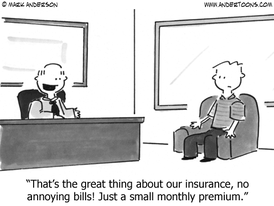 Life insurance can be a confusing topic. There are many different flavors and choosing the right coverage for your needs and budget can be difficult. Throw in the fact that life insurance agents goal of collecting a commission check may be at odds with your goal of obtaining the best protection for the lowest price and you have a recipe for disaster. Let’s start by getting to know some of the basic flavors of life insurance available to you. While this is not a complete guide to all the life insurance options available nor does this explain all the nuances of each policy type, it is useful as a primer to get you started. Term Life Insurance Term insurance is the most basic and the least expensive type of life insurance policy available. Term insurance is pure protection. You give the insurance company a premium and the commit to paying your beneficiaries a death benefit if you die during the policy’s term. Once the term has expired you no longer have life insurance protection and the insurance company no longer has an obligation to pay. One-year non-renewable term insurance is the absolute cheapest type of policy you can buy, but that is rarely the type of policy you will need. Usually you need protection for longer than a year, so insurance companies came up with multi year guaranteed renewable term policies to meet that need. You can often find 5 year to 20 year guaranteed renewable coverage that can be used to customize coverage for just about any situation. Because the policies cover multiple years and have guaranteed renewability, premiums are a bit higher. You can also add level premium guarantees to the coverage, so you know what your premiums will be for the entire term of the contract. Level premiums mean there is a bit more risk for the insurance company which gets passed along to you the consumer in the form of higher premiums. Many young families can use term insurance to protect against premature death and until they have accumulated enough capital to no longer need as much protection. For instance, new parents might purchase enough coverage to protect against the loss of wages if one spouse dies and provide funds for childcare and education until their children graduate from college with a fifteen or twenty-year level premium term policy. After that term expires their need for insurance may well be much lower and they can follow it up with a ten-year level premium policy to provide protection until retirement when they will likely not need any life insurance coverage. Whole Life Insurance Whole life coverage as the name implies will last your entire life. The insurance company issues you a policy with a premium based on your age when the policy is issued. The premium you pay is calculated to cover the cost of term coverage for you, pay the agent, and have some money left over to go into a savings account inside the policy. Usually there is a stated interest rate that your excess premiums earn inside the insurance policy. As you continue to make premium payments, you gradually build up enough money inside the policy to either increase the policy’s death benefit or to stop making premium payments altogether. Whole life coverage is usually the most expensive flavor of life insurance you can buy. There was an old adage that said buy term and invest the savings yourself for a better long-term outcome but having worked with many clients who are terrible savers, I do recognize the place for whole life insurance policies in many family’s insurance portfolio. Perhaps it is used as a foundation that you build term coverage on to meet all your needs for all your life. Universal Life Insurance Universal insurance works like whole life but rather than earning a guaranteed rate, the excess premiums are credited with an interest rate that floats with market rates. These policies were popular when interest rates were high. As interest rates came down over the past two decades many of these policies collapsed as the interest rate assumptions made when they were issued failed to materialize leaving the owners with much higher than anticipated premiums or reduced or even eliminated death benefits. Variable Universal Life Okay, take a universal insurance policy and make the savings account inside the policy a high priced mutual fund and what you end up with is variable universal life. If the mutual funds you own inside the policy earn enough net of fees, your premiums vanish or your death benefit increases. If you can find a variable universal policy with low expenses this is a good idea, but determining all the fees being charges to your account can be very challenging. In the end life insurance is often a must for building a solid foundation for your family's financial plan. Life insurance is the one product that can create wealth where none existed before. Life insurance provides the cash your family will need to replace the earnings or human capital of a loved one. Life insurance is a valuable tool for providing protection for your family, but it is almost never a good tool for investing. If your agent talks about the investment properties of a life insurance product you should see this as a red flag and seek out a second opinion. |
Archives
April 2024
Categories
All
|
 RSS Feed
RSS Feed